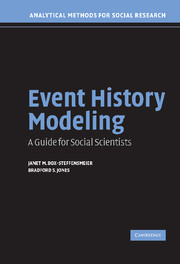Book contents
- Frontmatter
- Contents
- List of Figures
- List of Tables
- Preface
- 1 Event History and Social Science
- 2 The Logic of Event History Analysis
- 3 Parametric Models for Single-Spell Duration Data
- 4 The Cox Proportional Hazards Model
- 5 Models for Discrete Data
- 6 Issues in Model Selection
- 7 Inclusion of Time-Varying Covariates
- 8 Diagnostic Methods for the Event History Model
- 9 Some Modeling Strategies for Unobserved Heterogeneity
- 10 Models for Multiple Events
- 11 The Social Sciences and Event History
- Appendix: Software for Event History Analysis
- References
- Index
1 - Event History and Social Science
Published online by Cambridge University Press: 05 September 2012
- Frontmatter
- Contents
- List of Figures
- List of Tables
- Preface
- 1 Event History and Social Science
- 2 The Logic of Event History Analysis
- 3 Parametric Models for Single-Spell Duration Data
- 4 The Cox Proportional Hazards Model
- 5 Models for Discrete Data
- 6 Issues in Model Selection
- 7 Inclusion of Time-Varying Covariates
- 8 Diagnostic Methods for the Event History Model
- 9 Some Modeling Strategies for Unobserved Heterogeneity
- 10 Models for Multiple Events
- 11 The Social Sciences and Event History
- Appendix: Software for Event History Analysis
- References
- Index
Summary
Social scientists often examine events, for example, the occurrence of a militarized dispute, unemployment, or adoption. Events like these connote change or represent a transition from one state to another. Frequently, this concern with events is tied to an interest in the history preceding the event, for example, the number of years leading up to a war or the number of months a child is in foster care before adoption. History, thought of in this way, involves timing, and for many research questions, the timing of social change is at least as interesting as understanding the event culminating the history. Such questions naturally lend themselves to an examination of both the occurrence of an event and the history leading up to the event's occurrence.
The issues of timing and change are relevant for social science and bear on many hypotheses and theories with which social scientists regularly work. Such hypotheses and theories may have observable implications related to timing and change. Moreover, methods accounting for timing and change often naturally follow from hypotheses or theoretical expectations embedded in the research question. Understanding an “event history” entails a consideration of not only if something happens, but also when something happens. An event history is longitudinal and event history analysis typically involves the statistical examination of longitudinal data collected on a set of observations. While a wide variety of statistical models may be constructed for event history data, at the most basic level, all event history models have some common features.
- Type
- Chapter
- Information
- Event History ModelingA Guide for Social Scientists, pp. 1 - 6Publisher: Cambridge University PressPrint publication year: 2004



